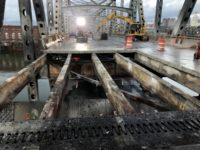Two and a half years after beginning work on a $300-million first phase to replace two 50-year-old freeway bridges across the Anacostia River, the District of Columbia Dept. of Transportation has authorized a $90.7-million add-on to the project. The extra work will complete functional and operational requirements on the north side of the river, creating direct connections between the Southeast-Southwest Freeway and Interstate/state Route 295.
“This will eliminate a long-standing problem of motorists having to use local streets to get from one freeway to another,” explains Brook Brookshire, vice president of Virginia Beach, Va.-based Skanska USA Civil, which is handling both phases of the project with its joint-venture partner, Facchina Construction Co., La Plata, Md.
In 2009, the District of Columbia Dept. of Transportation (DCDOT) used design-build to model a procurement approach to determine how much of the project it could afford.
“Skanska-Facchina’s plan let us get the river crossing going and allowed us sufficient time to get enough funding to complete the project’s goals,” says DCDOT's chief engineer, Ronaldo “Nick” Nicholson. “Now, we’ll be able to tie the 11th Street Corridor together and create new economic opportunities for the area.”
The main bridges are approximately 82% complete and on track for substantial completion later this year, according to Brookshire. Phase-two work, which began in early June, includes the removal and replacement of two flyover bridges with 700-ft and 880-ft-long steel-girder structures and the reconstruction of the existing Southeast-Southwest Freeway from an underpass to an at-grade boulevard. Local travelers also will benefit from having 12th Street extended across CSX Railroad tracks.
Unlike other construction projects near the D.C. waterfront, the presence of good clay soils is expected to make foundation work relatively straightforward. Most will be H-piles driven to approximately 65 ft. Because a constrained area between the railroad tracks and Southeast-Southwest Boulevard made impractical a pile-supported footing for a curved section of the inbound ramp, two 10-ft-dia foundation shafts will be drilled to 95 ft below grade.
“Given that it supports the apex of a long-span curve on the inbound ramp, we felt a beefier foundation was needed,” Brookshire says.
Skanska-Facchina’s contract calls for liquidated damages of $10,000 per day past the scheduled completion date of Nov. 15, 2015.







Post a comment to this article
Report Abusive Comment